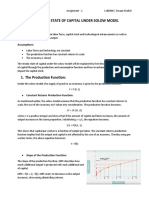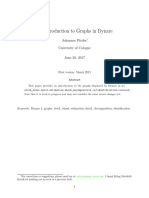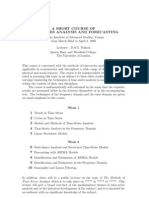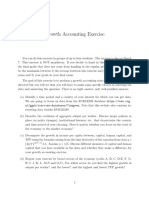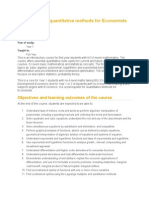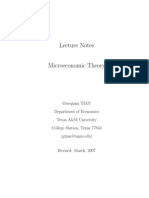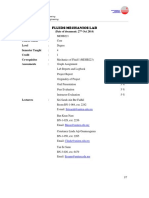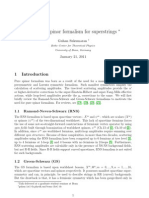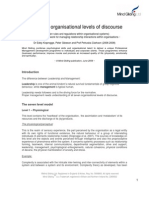Notes On Log-Linearization
Uploaded by
.cadeau01Notes On Log-Linearization
Uploaded by
.cadeau011
Organization
Introduction
Basic Idea
Log-Linearization
Examples
2
The solutions to many discrete time
dynamic economic problems take the
form of a system of non-linear
difference equations.
Many modern economic models are
hard to solve due to non-linearities.
3
1. Introduction
One method to solve and analyze nonlinear
dynamic stochastic models is to approximate
the nonlinear equations characterizing the
equilibrium with log-linear ones.
The strategy is to use a first order Taylor
approximation around the steady state to
replace the equations with approximations,
which are linear in the log-deviations of the
variables.
4
2. Basic Idea
Consider an arbitrary univariate function,
Taylors theorem tells us that this can be
expressed as a power series about a particular
point x, where x belongs to the set of possible
x values:
5
Taylor Series
( ) f x
2
( ) ( )
( ) ( ) ( ) ( )
1! 2!
f x f x
f x f x x x x x
' ''
= + +
3
( )
( ) ...
3!
f x
x x
'''
+ +
For a function that is sufficiently smooth,
the higher order derivatives will be small,
and the function can be well approximated
(at least in the neighborhood of the point of
evaluation, x) linearly as:
For an arbitrary multivariate function,
6
( ) ( ) ( )( ) f x f x f x x x
'
= +
( , ) ( , ) ( , )( ) ( , )( )
x y
f x y f x y f x y x x f x y y y = + +
One particularly easy and very common
approximation technique is that of log-
linearization.
First, take natural logs of the system of
non-linear difference equations.
Linearize (using Taylor series) the logged
difference equations about a particular
point (usually a steady state)
7
3. Log-Linearization
Simplify until we have a system of
linear difference equations where the
variables of interest are percentage
deviations about a point (again, usually
a steady state).
8
Cobb-Douglass production function:
Take logs
Do the first order Taylor series
9
4. Examples
1
t t t t
y a k n
o o
=
ln ln ln (1 ) ln
t t t t
y a k n o o = + +
1 1
ln ( ) ln ( )
t t
y y y a a a
y a
+ = +
(1 )
ln ( ) (1 ) ln ( )
t t
k k k n n n
k n
o o
o o
+ + + +
Simplify as percentage deviations
Note that,
Therefore,
Using hat variables being percentage deviations
from steady state, we have
10
1 1 (1 )
( ) ( ) ( ) ( )
t t t t
y y a a k k n n
y a k n
o o
= + +
ln ln ln (1 ) ln y a k n o o = + +
(1 ) y a k n o o = + +
Note that
Given the fact that
11
then
log log
t t
z z z =
log( )
t
z
z
=
log(1 ) log(1 % )
t
z z
change
z
= + = +
%change =
In words, log-deviations can be interpreted as
percentage deviations from the steady state
log log
t t
z z z =
log(1 ) z z + =
z
for a small
12
The economy resource constraint:
Take logs
Do the first order Taylor series
Simplify as percentage deviation
t t t
y c i = +
ln ln( )
t t t
y c i = +
1 1 1
ln ( ) ln( ) ( ) ( )
( ) ( )
t t t
y y y c i c c i i
y c i c i
+ = + + +
+ +
c i
y c i
y y
= +
13
Capital accumulation equation:
Take logs
Do the first order Taylor series
Simplify as percentage deviation
1
(1 )
t t t
k i k o
+
= +
1
ln ln( (1 ) )
t t t
k i k o
+
= +
1
1
ln ( ) ln( (1 ) )
t
k k k i k
k
o
+
+ = +
1
(1 )
t t t
i
k i k
k
o
+
= +
1 1
( ) ( )
( (1 ) ) ( (1 ) )
t t
i i k k
i k i k
o
o o
+ +
+ +
14
Consumption Euler equation:
Take logs
Do the first order Taylor series
Simplify as percentage deviation
1
( ) (1 )
t
t
t
c
r
c
o
|
+
= +
1
ln ln ln ln(1 )
t t t
c c r o o |
+
= + +
1
ln ( ) ln ( )
t t
c c c c c c
c c
o o
o o
+
+
1
ln ln(1 ) ( )
(1 )
t
r r r
r
| = + + +
+
1
1
t t t
c c r
o
+
=
with
( )
t t
r r r =
1
1
(1 ) r
=
+
and
Note that
Since interest rate (r) is already a percent, it is common
to leave it in absolute (as opposed to percentage)
deviations. Therefore,
We approximate the term
The equation says that the growth rate
of consumption is approximately proportional to the
deviation of the real interest rate from steady state
interpreted as the elasticity of inter-temporal
substitution of consumption
15
( )
t t
r r r =
1
1
(1 ) r
=
+
( )
1
1
t t t
c c r o
+
=
1 o
You might also like
- The Steady State of Capital Under Solow Model The Solow ModelNo ratings yetThe Steady State of Capital Under Solow Model The Solow Model3 pages
- Wiley - Student Solutions Manual To Accompany Introduction To Time Series Analysis and Forecasting - 978-0-470-43574-80% (1)Wiley - Student Solutions Manual To Accompany Introduction To Time Series Analysis and Forecasting - 978-0-470-43574-83 pages
- EC 744 Lecture Notes: Incomplete Markets and Bewley Models: Jianjun MiaoNo ratings yetEC 744 Lecture Notes: Incomplete Markets and Bewley Models: Jianjun Miao39 pages
- X-Efficiency Theory, Evidence and Applications - Frantz0% (1)X-Efficiency Theory, Evidence and Applications - Frantz237 pages
- [BOOK] a Primer in Econometric Theory - Stachurski 2016No ratings yet[BOOK] a Primer in Econometric Theory - Stachurski 2016398 pages
- A Short Course of Time-Series Analysis and Forecasting by D S G PollockNo ratings yetA Short Course of Time-Series Analysis and Forecasting by D S G Pollock133 pages
- Essays On The Economic History of The Argentine Republic. Carlos F. Díaz AlejandroNo ratings yetEssays On The Economic History of The Argentine Republic. Carlos F. Díaz Alejandro564 pages
- EC221 Principles of Econometrics Solutions PSNo ratings yetEC221 Principles of Econometrics Solutions PS6 pages
- Recursive Macroeconomic Theory Third Edition Lars Ljungqvist 2024 scribd download100% (6)Recursive Macroeconomic Theory Third Edition Lars Ljungqvist 2024 scribd download60 pages
- Introduction To Quantitative Methods For EconomistsNo ratings yetIntroduction To Quantitative Methods For Economists8 pages
- EC3115 Monetary Economics Subject GuideNo ratings yetEC3115 Monetary Economics Subject Guide235 pages
- Mathematics For Economics (Implicit Function Theorm)No ratings yetMathematics For Economics (Implicit Function Theorm)10 pages
- Lecture Notes, Microeconomic Theory - Guoqiang TIAN 2007-03 R20070904BNo ratings yetLecture Notes, Microeconomic Theory - Guoqiang TIAN 2007-03 R20070904B487 pages
- (F23) ECON - 536 Topics in Mathematical Methods For EconomistNo ratings yet(F23) ECON - 536 Topics in Mathematical Methods For Economist3 pages
- Graduate Macro Theory II: Notes On Log-Linearization: Eric Sims University of Notre Dame Spring 2011No ratings yetGraduate Macro Theory II: Notes On Log-Linearization: Eric Sims University of Notre Dame Spring 20115 pages
- Difference Equations For Economists PDFNo ratings yetDifference Equations For Economists PDF134 pages
- Principles of Biostatistics and Data AnalysisNo ratings yetPrinciples of Biostatistics and Data Analysis51 pages
- Stochastic Processes and The Mathematics of Finance: Jonathan Block April 1, 2008No ratings yetStochastic Processes and The Mathematics of Finance: Jonathan Block April 1, 2008132 pages
- Understanding Evil - An Interdisciplinary ApproachNo ratings yetUnderstanding Evil - An Interdisciplinary Approach239 pages
- Positioning A Place Developing A Compelling Destination BrandNo ratings yetPositioning A Place Developing A Compelling Destination Brand18 pages
- 92-002-Transcendental Appearance (Mumbai)No ratings yet92-002-Transcendental Appearance (Mumbai)7 pages
- Business English 2: Unit 1 Verb "Be" & Personal Information QuestionsNo ratings yetBusiness English 2: Unit 1 Verb "Be" & Personal Information Questions9 pages
- Effective Church Leadership and The Lay: The Role of The Presbyterian Young AdultNo ratings yetEffective Church Leadership and The Lay: The Role of The Presbyterian Young Adult21 pages
- Stuart Schneiderman - Rat Man-New York University Press (1986)No ratings yetStuart Schneiderman - Rat Man-New York University Press (1986)122 pages
- An Evaluation of the use of Marking Schemes in the Teaching and Learning of Commerce at Ordinary level: A Case Study of Five (5) Secondary Schools in Chiefs Sayi and Jiri areas in Gokwe South District, Midlands, Zimbabwe.No ratings yetAn Evaluation of the use of Marking Schemes in the Teaching and Learning of Commerce at Ordinary level: A Case Study of Five (5) Secondary Schools in Chiefs Sayi and Jiri areas in Gokwe South District, Midlands, Zimbabwe.19 pages
- Spirituality and Palliative Care A Model of NeedsNo ratings yetSpirituality and Palliative Care A Model of Needs7 pages
- Cases: Ohio Lottery: Innovative Research Design Drives WinningNo ratings yetCases: Ohio Lottery: Innovative Research Design Drives Winning18 pages
- SCHEIN (1976) Individual Power and Political BehsvioutNo ratings yetSCHEIN (1976) Individual Power and Political Behsviout10 pages
- Grade: Critical Reading As A Form of ReasoningNo ratings yetGrade: Critical Reading As A Form of Reasoning8 pages
- Anxiety Samir Chopra - The ebook in PDF format is ready for download100% (1)Anxiety Samir Chopra - The ebook in PDF format is ready for download50 pages
- The Seven Organisational Levels of Discourse100% (1)The Seven Organisational Levels of Discourse9 pages
- (Alexander Golitzin Bogdan G. Bucur (Ed.) ) Mystag (B-Ok - CC)100% (1)(Alexander Golitzin Bogdan G. Bucur (Ed.) ) Mystag (B-Ok - CC)373 pages
- The Steady State of Capital Under Solow Model The Solow ModelThe Steady State of Capital Under Solow Model The Solow Model
- Wiley - Student Solutions Manual To Accompany Introduction To Time Series Analysis and Forecasting - 978-0-470-43574-8Wiley - Student Solutions Manual To Accompany Introduction To Time Series Analysis and Forecasting - 978-0-470-43574-8
- EC 744 Lecture Notes: Incomplete Markets and Bewley Models: Jianjun MiaoEC 744 Lecture Notes: Incomplete Markets and Bewley Models: Jianjun Miao
- X-Efficiency Theory, Evidence and Applications - FrantzX-Efficiency Theory, Evidence and Applications - Frantz
- [BOOK] a Primer in Econometric Theory - Stachurski 2016[BOOK] a Primer in Econometric Theory - Stachurski 2016
- A Short Course of Time-Series Analysis and Forecasting by D S G PollockA Short Course of Time-Series Analysis and Forecasting by D S G Pollock
- Essays On The Economic History of The Argentine Republic. Carlos F. Díaz AlejandroEssays On The Economic History of The Argentine Republic. Carlos F. Díaz Alejandro
- Recursive Macroeconomic Theory Third Edition Lars Ljungqvist 2024 scribd downloadRecursive Macroeconomic Theory Third Edition Lars Ljungqvist 2024 scribd download
- Introduction To Quantitative Methods For EconomistsIntroduction To Quantitative Methods For Economists
- Mathematics For Economics (Implicit Function Theorm)Mathematics For Economics (Implicit Function Theorm)
- Lecture Notes, Microeconomic Theory - Guoqiang TIAN 2007-03 R20070904BLecture Notes, Microeconomic Theory - Guoqiang TIAN 2007-03 R20070904B
- (F23) ECON - 536 Topics in Mathematical Methods For Economist(F23) ECON - 536 Topics in Mathematical Methods For Economist
- Graduate Macro Theory II: Notes On Log-Linearization: Eric Sims University of Notre Dame Spring 2011Graduate Macro Theory II: Notes On Log-Linearization: Eric Sims University of Notre Dame Spring 2011
- Stochastic Processes and The Mathematics of Finance: Jonathan Block April 1, 2008Stochastic Processes and The Mathematics of Finance: Jonathan Block April 1, 2008
- Understanding Evil - An Interdisciplinary ApproachUnderstanding Evil - An Interdisciplinary Approach
- Positioning A Place Developing A Compelling Destination BrandPositioning A Place Developing A Compelling Destination Brand
- Business English 2: Unit 1 Verb "Be" & Personal Information QuestionsBusiness English 2: Unit 1 Verb "Be" & Personal Information Questions
- Effective Church Leadership and The Lay: The Role of The Presbyterian Young AdultEffective Church Leadership and The Lay: The Role of The Presbyterian Young Adult
- Stuart Schneiderman - Rat Man-New York University Press (1986)Stuart Schneiderman - Rat Man-New York University Press (1986)
- An Evaluation of the use of Marking Schemes in the Teaching and Learning of Commerce at Ordinary level: A Case Study of Five (5) Secondary Schools in Chiefs Sayi and Jiri areas in Gokwe South District, Midlands, Zimbabwe.An Evaluation of the use of Marking Schemes in the Teaching and Learning of Commerce at Ordinary level: A Case Study of Five (5) Secondary Schools in Chiefs Sayi and Jiri areas in Gokwe South District, Midlands, Zimbabwe.
- Cases: Ohio Lottery: Innovative Research Design Drives WinningCases: Ohio Lottery: Innovative Research Design Drives Winning
- SCHEIN (1976) Individual Power and Political BehsvioutSCHEIN (1976) Individual Power and Political Behsviout
- Anxiety Samir Chopra - The ebook in PDF format is ready for downloadAnxiety Samir Chopra - The ebook in PDF format is ready for download
- (Alexander Golitzin Bogdan G. Bucur (Ed.) ) Mystag (B-Ok - CC)(Alexander Golitzin Bogdan G. Bucur (Ed.) ) Mystag (B-Ok - CC)

